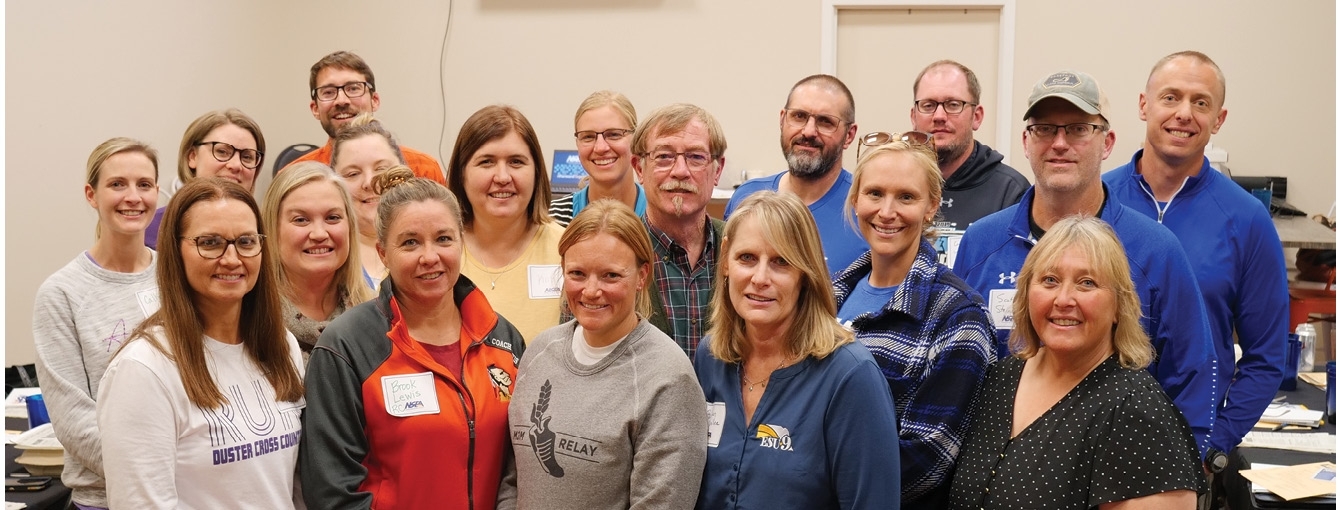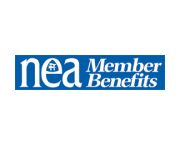AT THE TABLE: Locals look for solutions on pay, staff shortages through bargaining
Ahead of the 2023-24 bargaining season, NSEA members from 13 local associations traveled to Kearney to discuss ways to increase wages, secure benefits, and improve teaching and learning conditions. As is usual, negotiations teams will address topics such as salary increases, health insurance coverage, class size, plan time and retirement and, this year, many locals will also be tackling staff shortages and teacher retention
Local leaders from Amherst, Aurora, Axtell, Elm Creek, Gibbon, Holdrege, Hastings, Kearney, Overton, Red Cloud, SCATA, Shelton and Wilcox-Hildreth gathered in mid-October for NSEA’s Greater Nebraska Bargaining meeting. Participants were joined by NSEA’s Collective Bargaining Specialist Jen Dubas and Organizational Specialists Kristen Sedlacek, Kim Story and Patrick Fielder.
The statutory start of bargaining for the 2023-24 contract is Nov. 1. Association and school board bargaining teams then have essentially two months to bargain, with a goal of wrapping up negotiations with a tentative agreement sometime in January. For Holdrege Education Association President Deb Komenda, the cost of living increase is a concern that will play into her negotiations this fall.
“This year we have a lot of information about how much inflation has changed in even the last year,” she said. “We’d like to use the information that was in The Voice on how the buying power of our salaries has decreased by about $2,000 to show the district that we really need to do something for our teachers.”
As trusted professionals, educators are best equipped to advocate for change at the table but when bargaining begins, there are invariably questions that arise. NSEA has staff ready to assist with negotiations. From our PK-12 local associations to statewide Higher Education teams, NSEA has the expertise and resources to help.
Competitive Pay
Anna Peralez was elected president of the UMÓⁿHOⁿ Nation Education Association just a few months ago. Previously, she served as lead negotiator for her local. Peralez attended the NSEA U Bargaining Strategy Workshop over the summer to help prepare for this year’s negotiations.
“I know this year will be a different experience for me because the last time I was at the table it was COVID, and we were worried our schools might get shut down. We were in a bit of a rush to get an agreement.”
Peralez said that the workshop gave her a head start on a comp study for UMÓⁿHOⁿ Nation—a first for her local.
“Because our school had never done the study before, it took a little while to get the information we needed from the district,” she said. “Attending the conference felt like having a community of help. It was just a good group to be a part of. I came away with new ideas for my local.”
Like many schools trying to hire in a tight job market, UMÓⁿHOⁿ Nation offered hiring bonuses to attract new teachers. While these one-time bonuses may have helped fill classrooms in the short term, Peralez believes the district must next focus on long-term improvements in teacher attrition —and that includes competitive pay.
“Our teachers on longevity never saw any of the hiring-bonus money or anything like that. We’re going into this year looking for solutions to how we get people to stay here,” said Peralez.
Research has shown that increasing base pay has been connected to attracting more and higher-quality teaching candidates, and districts that offer higher pay have had lower levels of teacher attrition. This will likely be a key issue for districts and local school boards as well. When Kearney Public Schools unveiled its new strategic plan, staff recruitment and retention were outlined as a key pillar. For Kearney Education Association Lead Negotiator Kevin Witte, the new strategic plan signals hope for a collaborative approach to bargaining with the district.
“I think from a negotiations standpoint, we’re excited that our administration, our board and our key negotiation group, we’re all actually working on the same thing,” he said.
Insurance Coverage
Providing affordable, high-quality health care benefits is an important tool to improving retention and recruitment.
“For our negotiations team a huge priority is trying to close the gap on insurance costs. As insurance goes up, it gets harder and harder for our members to make up the difference,” Witte explained.
Many agreements contain a pasted version of the 22-23 premium/coverage table to supplement the specific language that details the terms of the benefit provided by the district. NSEA advises locals to be thorough when proofreading this section of the agreement and watch for deductible amounts, premium amounts and terms of the coverage.
Follow the Calendar
Locals that have met to bargain at least four times and have still not reached agreement should be in regular consultation with their NSEA organizational specialist by January.
“Provisions in Nebraska law force negotiations to adhere to tight timelines once bargaining nears the end of January, so working closely with your NSEA organizational specialist becomes critical,” said NSEA Collective Bargaining Specialist Jen Dubas. “Negotiators should be aware of problematic comments, proposals and strategies they observe during contract talks, and they should share those issues with their NSEA organizational specialist.”
A Reason to Belong
There are countless reasons membership in your professional association is a good idea and bargaining is a key reason for KEA President Katie Brodine.
“Something our new educators always ask is, ‘Why should I belong?’ And one of the first answers that I always provide is whether you are a member or not your local negotiates on your behalf. The key thing here is that the more members we have, the more bargaining power we have to improve your salary and your benefits.”
L.E.A.R.N — Providing valuable learning opportunities for educators: LearnNebraska.org Visit Website








